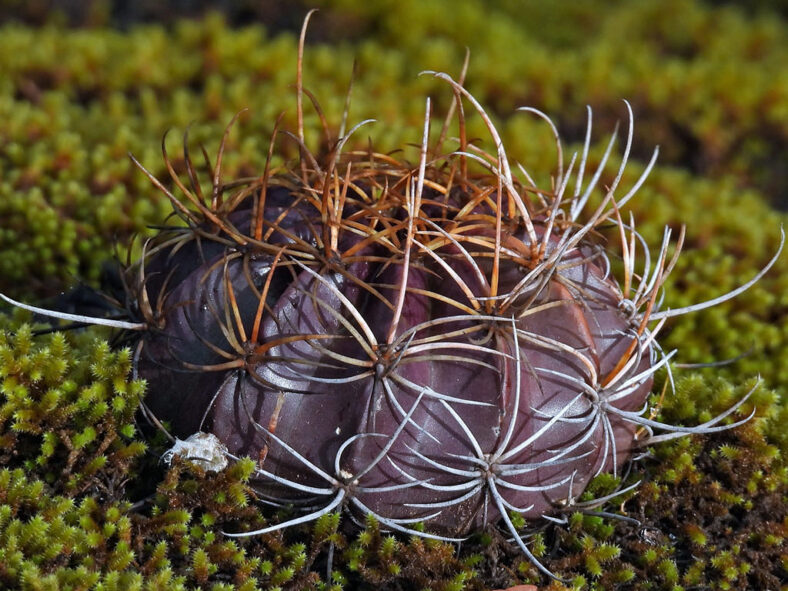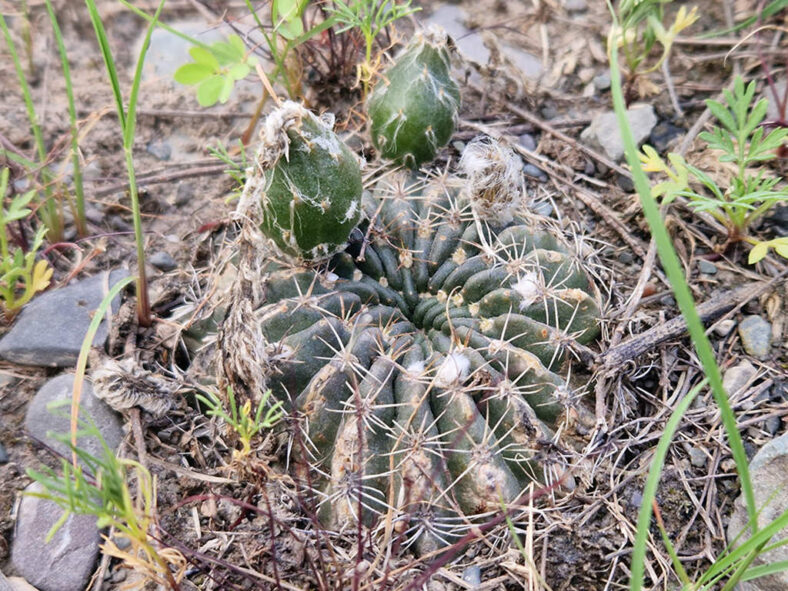Lobivia ancistrophora is a small cactus with large, spectacularly showy flowers with long floral tubes. It is a highly variable species in growth habit, spination, and flower color and size.
Scientific Name
Lobivia ancistrophora (Speg.) Schlumpb.
Synonym(s)
Echinopsis ancistrophora, Mesechinopsis ancistrophora, Pseudolobivia ancistrophora
Scientific Classification
Family: Cactaceae
Subfamily: Cactoideae
Tribe: Cereeae
Subtribe: Trichocereinae
Genus: Lobivia
Etymology
The specific epithet "ancistrophora" (pronounced "an-kiss-troh-FOR-uh") means "hook-bearing" and refers to the central spines of this species, which are usually curved or hooked.
Origin
Lobivia ancistrophora is native to northwestern Argentina (Tucumán, Salta, and Jujuy) and southern Bolivia (Tarija and Chuquisaca). It grows primarily in grasslands, shrublands, and forests at elevations ranging from 1,970 to 8,200 feet (600 to 2,500 m).
Description
Lobivia ancistrophora, also known as Echinopsis ancistrophora, is a small cactus with spherical, grey-green stems that are slightly depressed at the top. This cactus typically grows as a solitary stem but can also form clumps. The stems can reach a diameter of up to 3.2 inches (8 cm) and have 15 to 20 sharp ribs lined with small, cream-colored areoles, spaced up to 0.6 inches (1.5 cm) apart. Each areole typically bears one central spine, which can be more or less curved or hooked, though it can sometimes be absent, and 3 to 7 radial spines. The central spine is light brown and can grow up to 0.8 inches (2 cm) long, while the radial spines are whitish and can reach a length of 0.6 inches (1.5 cm). Occasionally, the spines can be pretty short and concealed within the areole's wool, giving the stem a spineless appearance.
In spring or early summer, Lobivia ancistrophora produces white to light pink, funnel-shaped flowers that are slightly curved above the ovary. The flowers appear on the side near the top of the stems and open at night. They can measure up to 9.6 inches (24 cm) in length and 2.8 inches (7 cm) in diameter. The fruits are ellipsoid in shape, ranging from dirty green to greenish-purple, and can reach up to 0.6 inches (1.5 cm) in length and 0.3 inches (0.8 cm) in diameter.

Forms of Lobivia ancistrophora
How to Grow and Care for Lobivia ancistrophora
Light: Lobivia ancistrophora thrives in full sun to partial shade. When grown indoors, placing the plant near a window that receives at least 6 hours of sunlight daily is ideal. In the spring, if possible, move the plant outdoors, but be sure to acclimate it to direct sunlight gradually to avoid sunburn.
Soil: This cactus prefers sandy or gritty soil, but it can tolerate other soil types as long as they provide good drainage. You can use a commercial cactus potting soil mix or create your own.
Temperature: Lobivia ancistrophora is highly tolerant of high temperatures but prefers cooler conditions in winter, ideally between 41°F and 50°F (5°C and 10°C). It is hardy in USDA Plant Hardiness Zones 9a-11b, which have average annual extreme minimum winter temperatures ranging from 20°F to 50°F (-6.7°C to 10°C).
Watering: During the growing season, water the plant thoroughly but allow the soil to dry out completely before watering again. Avoid letting the container sit in a saucer of water. Suspend watering during winter.
Fertilizing: This cactus benefits from fertilizing during the growing season. Apply a water-soluble fertilizer and suspend feeding during winter when the plant is dormant.
Repotting: Repot as needed, preferably in late winter or early spring, using a container that is slightly larger and has drainage holes. Ensure the soil is dry before repotting.
Propagation: Lobivia ancistrophora is easy to propagate from offsets that grow around the base of the stems. The best time to remove offsets is in early summer.
Learn more at How to Grow and Care for Echinopsis.
Toxicity of Lobivia ancistrophora
Lobivia ancistrophora is non-toxic to humans and pets; however, it is best to keep it out of reach of pets and children due to its sharp spines.
Links
- Back to genus Lobivia
- Succupedia: Browse succulents by Scientific Name, Common Name, Genus, Family, USDA Hardiness Zone, Origin, or cacti by Genus
Photo Gallery
Click on a photo to see a larger version.


